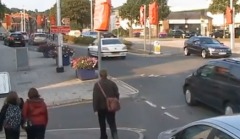
Still from video, watch it below.
Gridlock and road rage are an unfortunate part of American traffic culture. How much do traffic lights have to do with that? Would we be more considerate of other road users without them? A small town in England decided to find out.
About a year ago, the small coastal town of Portishead, England embarked on an experiment. In order to relieve congestion that was choking their downtown with long delays, traffic engineers decided to turn off the traffic signals. Not surprisingly, there was negative outcry from citizens about the idea; but the results of the experiment, captured in the video below, were surprising.
According to on-the-street interviews, there was much more than just a vast improvement in congestion (and resulting emissions from idling cars). It seems that people became more considerate. One young girl talks about how someone stopped for her when she crossed the road, “It wouldn’t normally happen with the lights because they just look at the lights.”
And it wasn’t just an engineering exercise. The city also worked to reform traffic culture “from one of priority to equality.”
The experiment was so successful — with travel times falling by over 50% with no increase in crashes involving people walking — that the traffic lights have now been permanently turned off.
“Road capacity might be limited, but empathy is boundless,” says the video’s narrator, “All we need is the freedom to express it.” There’s definitely a need for more empathy on our streets here in Portland. I wonder if there are locations where fewer traffic lights would improve not just how our streets function, but how we treat each other while using them.


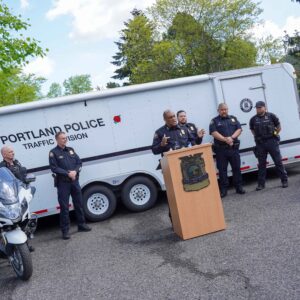
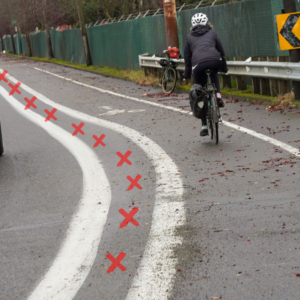
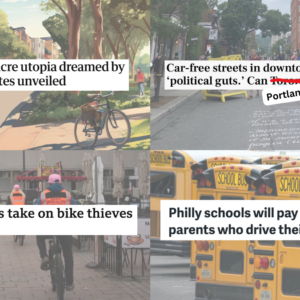
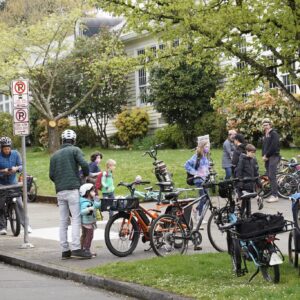
Thanks for reading.
BikePortland has served this community with independent community journalism since 2005. We rely on subscriptions from readers like you to survive. Your financial support is vital in keeping this valuable resource alive and well.
Please subscribe today to strengthen and expand our work.
Three cheers for bold experiments. What have we to lose?
Everyone yields.
Goodbye Jaywalking.
Hello Idaho Stop Law.
Glad someone’s finally questioning the idea that a senseless machine is more fit than a human being for the task of managing an intersection. Something has always bugged me about the fact that human authority and law are being delegated/ceded to a robot.
I liked what one of the kids said later in the video, about how drivers more likely to notice her (and let her cross) when they were paying attention to their surroundings instead of just signals.
I think we could do with a lot less signage on our roads. Ideally, people should just know what speed is acceptable, and shouldn’t need to have it spelled out every two blocks.
I’d like to see an American city of more than 50,000 people try this experiment. Maybe in jolly old England empathy is boundless, but not here.
I love the message someone put on the crosswalk sign post at SE 30th and Salmon…
“Forgive”
Very poignant.
See also this article about the thoughts of Hans Monderman, a traffic revolutionary…err, engineer in the Netherlands.
We went without lights at 81st and 82nd streets and Hazel Dell for several months. I didn’t find it pleasant as a cyclist. Perhaps I could adapt if I gave it a chance.
google maps view of the location of the intersections
Oh, I guess the big orange “Traffic Revision Ahead” signs planted in the middle of the bike lanes didn’t help my love for the lack of lights any.
Traffic signals were invented because waaaay back in the day, when there were FAR FEWER CARS ON THE ROAD, there were plenty of pedestrian fatalities and car collisions which necessitated some engineer to invent traffic signals. Relying on the same people whom already ignore one way streets, stop signs, red lights, and lanes on occasion to be all well a good in the total absence of any traffic control is a recipe for disaster.
I can imagine many roads where a constant stream of traffic would NEVER allow a single pedestrian or vehicle cross the flow of traffic without deliberately causing a collision. People have a bully mentality in cars, removing legally backed signals to limit that behavior is only going to further enable it.
love this article!!!!!
This concept is taken even further in parts of Europe. As Tim F say, Hans Monderman started it all–his theory is called Shared Space. Amazing stuff: http://www.shared-space.org/
Wishful thinking that’s gonna work here. Do you think someone in a 6000 lb Suburban is gonna stop for you on a bicycle? Good luck.
I’m with Red Five. American drivers have more of a sense of entitlement than European drivers. Won’t work, at least from the cyclists’ and pedestrians’ perspective.
My guess is most of the improvement in behavior is due to the Hawthorne Effect (no relation to the boulevard to SE Portland — unless we decide to try the experiment there). Behavior often improves when conditions change or subjects know they are being experimented upon. Give it a year, and I bet most people return to the same old selfishness.
I lived in England for a few years and would drive miles and miles through numbers of intersections and maybe face one or two lights. Roundabouts and common sense at T-intersections (not even stop signs!) led to smooth flow of traffic. It kills me that our few roundabouts in Portland have stop signs. I regularly run them and have my “letter of the law, spirit of the law” speech ready for the officer that pulls me over. Hasn’t happened yet.
GlowBoy #13 –
“Entitlement” is exactly the word here, here being the roads. Just about every situation that terrifies me, or makes me scream with rage, seems to come from perpetrator feelings of entitlement. Cyclists who blow through every kind of controlled and uncontrolled intersection, pedestrians who see you coming and cross against a red light anyway all seem to do these things because they, personally, should be allowed to.
It is interesting that so many of you ‘know’ how this won’t work here. Did you watch the movie? That is exactly what the folks in Portishead also predicted. I don’t know all the things that would or wouldn’t happen if an experiment like this would be tried in Portland, but think there’s plenty of reason to suspect your certainty.
It is good you folks weren’t around to discourage those who fought the Mt. Hood freeway. Oh, right, you were around; and they won anyway.
A couple of years ago, The Atlantic published an article by John Staddon titled, “Distracting Miss Daisy,” which basically posits that the proliferation of traffic signs and signals in the U.S. makes driving less safe rather than more. Here is the link if anyone is interested in a more in-depth analysis of the issue:
http://www.theatlantic.com/magazine/archive/2008/07/distracting-miss-daisy/6873/
Very interesting and plausable – would be great to try it in a few places here.
You know a quick way to check if this works?
Visit Hanoi. Or one of the other giant asian cities with no traffic lights. Or just look up the staggering number of fatalities in india, which also is lacking in them.
I see this idea just like I see roundabout.
Places that have had them for years are trying to get rid of them. Places that have only just gotten then exclaim about how amazing they are and want more.
Same with lights. Places that have them think its better without. I guarantee the pedestrians in hanoi wish there were signals that were respected.
A “mind in a rut” breaking idea….genius. Would love to see how it would play out here in narcissistic america….. but then we’re probably to fear ridden to even try. And J J …. lights in a place like Hanoi would mean 10 tries per light and thats the point.
I was in Cambodia, Pnom Phen, in 1997. Although they mostly drove motor scooters then, there were no stop lights. The traffic weaved through each other at intersections and just kept moving. If you wanted to cross a street, you just did, right through the sea of scooters, all moving around you at about 20 mph. Though slow, it was steady. I think we crossed town faster than we might here.
I think this would be interesting to try out in places like the Glisan/Cesar Chavez traffic circle where cars meet up with other cars. But then, just down the street where there are no significant intersections (and where I try to cross daily with my dogs) the line of cars speeding east is endless and with no cars to slow for, cars don’t see me and don’t stop for me.
I loved the statement toward the end of the video. To simply turn off the lights is not enough (paraphrase).
And, the blind person was not willing to use the intersection, so they had more work to do to really keep the idea of equality that they were striving for.
Seems like it all comes back to education and perception. Who am I and where do I fit in the grand scheme? If I think I’m the only one on the road or only focused on me, I’ll behave that way.
Perhaps because they’re all accustomed to roundabouts it’s easier to intermesh smoothly.
If you were cycling through this intersection would you take the lane and take your turn or would you stay as far [left] as practicable?…
Portishead is a city of 20,000, by the way.
Old news. It’s been tried (successfully) in several towns in Europe.
The real story here for your blog is–what are the implications of this for the money and time being spent on ongoing increases in bicycle related signage/markings/lights/etc.? Portland already has more of it than Amsterdam, for example, and we’re just getting started. Isn’t that interesting?
Places that have had them for years are trying to get rid of them.
Wrong, and you’re lumping the world together and pretending it’s homogeneous. There are medium-sized towns around the world that have *never* had the infrastructure–and are doing fine. There are European towns that have had it for decades–and are doing fine.
And traffic fatalities? The US has more per capita than Mumbai. Isn’t that interesting?
What about traffic circles? They have the benefit of forcing all road users to think about what they’re doing.
The entitlement mentioned here I think is an extension of cultural selfishness and our historic “manifest destiny” that has plagued this otherwise great country over the centuries. Furthermore, politicians – even at the lowest levels – are way too chicken to mention they even thought about doing something that might lose them a vote in a future election. Even if turning off the lights represented a paradigm shift in focusing people’s attention on their environment (instead of themselves), the People In Charge would never actually do it because they would be drummed out of office and their decision reversed. It’s a nice fantasy scenario, though.
Johnathan,
Great post and video, thank you.
Many comments above mention the use of traffic circles/roundabouts as a possible solutions. I spent a few months driving around New Zealand and found they worked very well for the flow of motorized traffic. I wonder however, how well traffic circles work for bike traffic and the interaction between bikes and cars in that kind of engineered situation? Can anyone point to a decent sized city where traffic circles work equally well for cars, bikes, and peds?
One thing I noticed in the video is that there did not seem to be any cross walk markings on the pavement to alert drivers of pedestrians. That might help improve their situation even further?
I travel through multiple uncontrolled intersections on one of my regular commute routes. Never had a problem there.
However, only yesterday a woman running a stop sign while making a left turn cut that corner way too tight and nearly clipped me in the process, as she was looking right to see that whe was safe to run the sign.
Anecdotal evidence says uncontrolled intersections are safer. Also the story did not imply that they de-signalized every intersection in the city. The Glisan 39th example is a good one. We need more of them.
I live near the Glisan/39th traffic circle and drive, walk, and ride through it. when I drive and there’s a bike on my right, I time with them to either follow them at a safe distance and run interference for them with other cars, or they follow along at my passenger side bumper and in that way I break the trail, so to speak. It’s all about timing and sharing.
When I walk, folks stop because the crossing is striped. When I ride, I do what I described above and keep all ears, eyes, hands and heart open. Gulp. But it works. There is enough space on the Glisan circle that I can ride the edge of the circle and still be safe.
Heard they were taking the stop signs off the circle. Have dreaded that, because it seems like it would be so uncontrolled, but now this article makes me think, let’s give it a try….see what happens.
Start taking away the DL and I am sure people would comply with the laws rather quickly. I think speed is a big factor.
I’d like to see an American city of more than 50,000 people try this experiment. Maybe in jolly old England empathy is boundless, but not here.
There are at least a couple of uncontrolled intersections around town where drivers have to cooperate in order for the intersection to work. The two that I can think of right off the bat are the west end of the Sellwood Bridge and the west end of the Ross Island bridge. In both cases there’s a pretty big backup of cars, there’s a through lane that has the right-of-way and one lane of traffic that is supposed to stop. In both cases during rush hour cars in the through lane will stop to let one car from the other lane in front of them. There’s no law that says they have to do it, but they do it because it’s the right thing to do.
I’m not saying this would work on a city-wide scale, and I don’t necessarily think that such behavior speeds up auto trips, but I do think that it could be made to work. Despite all of the rhetoric here I find Portland drivers to be pretty damn courteous.
My guess: remove all of the motorcar flow devices (paint, signs, signals) and we’ll have safer, more livable and less expensive roadways.
There are videos on youtube of downtown portland in the days before traffic lights, and all the streets are still two- way (delightful!). Looks good to me, think of the money we could save, both on the infrastructure itself and on electricity. I think this would work best where population is denser and the roads are well-used enough to keep speeds low.
As for blind people, nothing is easy for them- they are blind. If they don’t have a friend with them, I have no doubt a stranger will help them cross the street. As a bus driver I see it almost every day.
Roland (#2) – And it was more equitable when the robot was timed. Our current situation has a so-called “smart” robot which responds to any nearby cars but not always to bikes, and never automatically to pedestrians.
silkyslim (#3) – Exactly. Another problem with signals is that when a driver (or a cyclist) is paying attention to the signal, the actual threats that they could encounter are in their peripheral vision, making them less like to be noticed in time to react to them.
Blue Falcon in Boston (#9) – If all intersections were treated as an “all way” yield, the problems you envision might not be present. Then again, a lot of people are jerks…
Red Five (#12) – If all intersections were “all way” yields, then they’d already be mostly stopped. There’d be some driver intimidation, but I’m not sure it would be any worse than what we see now.
mh (#15) – That’s really kind of the root of all problems, isn’t it? We feel entitled, or we’re afraid someone else will be entitled over us. Bigotry, racism, sexism, rape, intimidation, religion – they all involve the exercise of power over another – because the perpetrator feels entitled to what they decide to take. I’m starting to think the Buddhists are right, and “attachment” *is* the root of all suffering. People are far too attached to certain outcomes, privileges, entitlements, because they feel they have an inherent right to them.
JJ (#19) – Your arguments seem to imply that breaking the status quo might be the best action. Perhaps we’re not meant to keep the same system more than a generation, as people get used to the system and start looking for ways to abuse it, or become complacent and stop paying attention to the features that are intended to promote safety. Every methodology has a place where it works, and a place where it doesn’t. I see no reason not to try it here, since turning off the signals doesn’t remove the infrastructure – if it doesn’t work, we just turn them back on again.
Matt #28: Yes, in the Netherlands there are lots of roundabouts with separated bike paths and crosswalks. Cars yield to bikes and peds upon exiting the roundabout, in addition to yielding to all traffic when entering. Bikes simply just go around the circle without stopping and exit accordingly. Works very well and I’ve never had a problem.
Here’s an example with a 2-way cycle track in the roundabout, which normally have 1-way cycle tracks in the circle:
http://www.youtube.com/watch?v=KkPbTvJZFSI
And an aerial of a standard one:
http://img196.imageshack.us/img196/9935/rs1enschederotondeknalh.jpg
Well, looks like it could save money on signals and decrease injuries and emissions at this location BUT:
* Vision-disabled will always be threatened
* In this example it increases automobile throughput from 1700 to 2000 vehicles
* I did not see one cyclist
* All these vehicles still do their nasty stuff outside of town
Shared Space is the latest defense of private automobilisation. Also, see here: http://hembrow.blogspot.com/2008/11/shared-space.html
That’s pretty cool. I think in my old age I might be becoming an anarchist.
I admit I was sceptical untill I watched the video. It looks like a huge improvement. I can’t imagine it would work here because people here like to have govt. control every move they make.
Does anyone know where the bikes are in this town? Do they have seperate paths for bikes? I didn’t see any bikes in the video
I wonder if they couldn’t have achieved a result similiar by changing the timing of the lights.
The reason a no signal road works so well is increases drivers fear and fear keeps you focused. It’s easy to become distracted when you’re approaching an intersection and there’s a light or stop sign, you don’t have to think, the device does it for you. Signals, lane stripes, bike lanes, signs all exist to make the very unnatural act of driving comfortable to the driver. The problem has become that driving is too comfortable. Everything goes smoothly and fine until it doesn’t, and then people are dead.
Without signals, everything is an unknown, every interaction with other road users requires care and attention to detail and focus. It forces people out of the illusion of safety and into a defensive role of having to protect them selves(and by default, other road users). The complacency vanishes.
As said in other comments above, “good luck getting other drivers to share”. It’s the usage of the signs, signals, and lanes that create this notion that a road is a car space and not a human space. Like somehow the cars are moving around humans instead of humans moving around cars. Make roads more human scale and the roads will become more humane.
Just my two cents.
I’ve often noticed how drivers will slow down for a speed bump, but not a person; will slow down for a red light, but not a person.
It’s like they’re just robots behind the wheel.
I love this idea of no traffic lights! Not sure it would work so great here in the States though – drivers aren’t given the tools to be as competent here (no mandatory driving lessons etc), and seem far more prone to distracted driving than anywhere I’ve seen in Europe.
The reason people are questioning whether this would work as well in the US as it has in other places (especially the Netherlands and some other countries) is that US laws are fundamentally the opposite of laws elsewhere.
In the Netherlands, Japan (but not the UK), the drivers face strict liability – they will be held at fault and pay with rare exceptions if they can prove the pedestrian or bicyclist was so negligent they could not possibly avoid the collision (and will still probably pay something anyways).
In the US, the cyclist or pedestrian is effectively presumed to be at fault unless they survive and can prove the motorist was drunk and had a revoked license.
In the US, pedestrians are typically required to yield to vehicles, and their right of way is typically not enforced even when it is theirs legally. Similarly, with Far right (FRAP) and mandatory bike lane (MBL) laws for cyclists, exceptions are routinely denied by motorists, law enforcement officeres, judges and juries, and motorists and police require bike lane use even if it is not mandatory, or tell bicyclists they are not allowed to use significant roads without bike lanes or shoulders regardless of actual law. Since they have no enforceable right of way, they can never hold motorists responsible for any collision.
In the Netherlands or other parts of Northern Europe, pedestrians and cyclists still have enforceable right of way even without lights – drivers will be prosecuted for hitting them.
In the US, without lights, the pedestrians and cyclists still have no real rights and now have no protection without the signal – if they are hit they are clearly not yielding or staying out of the motorists’ way as required by MBL or FRAP.
My impression (haven’t been to UK, only Japan) is that while the UK law may be similar to the US, if it works it is because not all of the enforcement is as biased as in the US. While motorists may not have strict liability in the UK, they cannot automatically transfer liability to the pedestrian or cyclist for not yielding
I think it’s dangerous to make the assumption that American drivers are human beings–that would be a BIG mistake.
This may work when there is only one traffic lane in each direction. As you increase the number of travel lanes, it seems that the absence of signals will become increasingly dangerous.
Oliver (#29), my anecdotal evidence contradicts yours saying that uncontrolled intersections are safer. I have personally witnessed numerous crashes at uncontrolled intersections.
Cyclist (#32) – I can’t speak to the details about the Ross Island, but your description of the west end of the Sellwood is not accurate. Traffic seeking to travel east on the Sellwood comes to a merge point at the bridge entrance. Traffic approaching from the North has the right-of-way, and traffic approaching from the South faces a yield sign, not a stop. When people ignore the traffic controls in place, they are not doing the right thing by allowing each side to take a turn. Instead, they are doing the wrong thing by using misguided notions of courtesy to take turns, resulting in a long back up of cars approaching from the North.
The traffic control device (yield sign) at this intersection is designed to allow the travel lane that carries more traffic to continue to flow more freely, while still allowing vehicles to not have to stop when approaching an intersection from a different travel lane, if conditions allow it. The tendency of Portland drivers to override traffic planning with courtesy notions results in unnecessary backups and other drivers making compensatory moves. In the Sellwood case, a significant number of vehicles use the Riverview Cemetery entrance as a turnaround to change their approach to the bridge from North to South. This allows them to take advantage of the take-a-turn approach and avoid the backup in what is supposed to be the right-of-way lane.